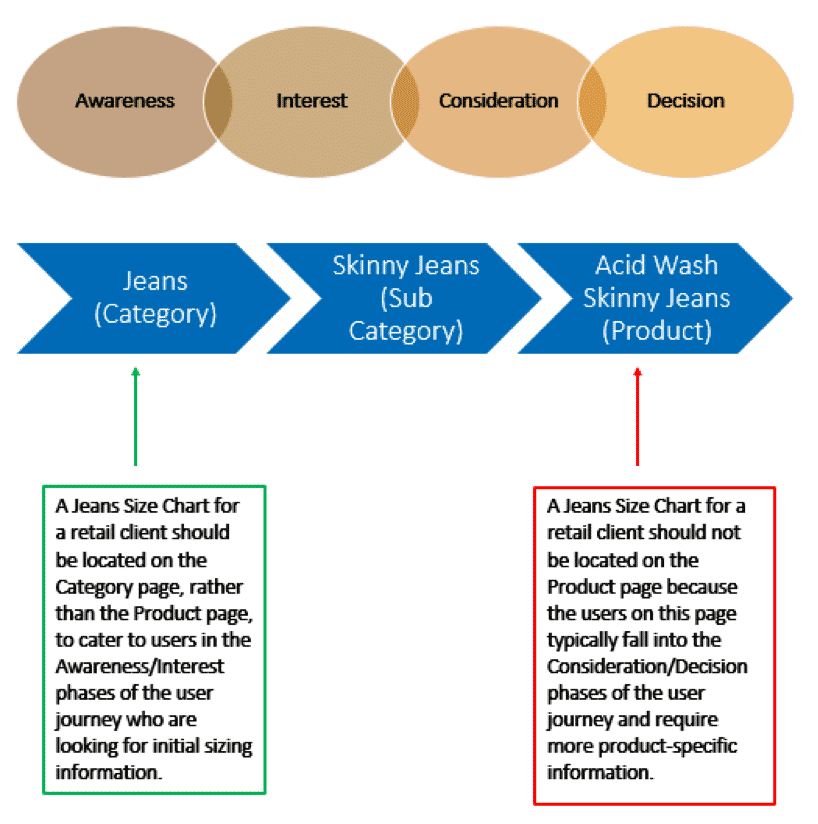At the heart of SEO is content, establishing a platform on which we can create beneficial user experiences. Optimized content brings users to your site and keeps them there, meeting them at their search intents and guiding them down the conversion funnel. However, we often forget to analyze where content leads users once they interact with it. This gap in the optimization process is where page pathing comes into play.
What is Page Pathing?
Page pathing is an analysis that tracks the path a user takes from entrance onto the site to exit. It reveals insights into user behavior that enable brands to better optimize content, funneling users to the closest and most beneficial conversion points. More specifically, page pathing helps to discover:
- Common user behaviors
- Frequent product browsing without purchase
- Internal site searches
- Cart abandonment
- Content optimization opportunities
- Thin content
- Unclear messaging
- Content discoverability and accessibility
- Content gaps
- Linking hierarchy improvements
- Orphaned content
- Gaps in hierarchy
- User journey roadblocks
- Broken navigational elements
- Unexpected technical issues on the site
- Keyword strategy improvements
- Content cannibalization
- Anchor text optimizations
How Do You Track User Paths?
Different tools can be used to track user paths, but the most efficient way to conduct a page pathing analysis is to leverage your analytics platforms. Most platforms have built-in reports to show how users interact with your site; our job as SEO managers is to understand how to use and interpret those reports. Here are a few examples of page pathing reports in common analytics platforms:
Adobe Analytics
- PathFinder
- Previous Page Flow Report
- Next Page Flow Report
- Entry Page Report
Google Analytics
- Landing Pages & Second Landing Pages Report
- Exit Pages Report
- Entry Pages Report
Note: Google Analytics has a Next Page Path dimension, but it was deprecated in 2015. To view previous page and next page flows, I prefer to create a custom report using Page and Previous Page Path as dimensions and Pageviews as a metric.
What Can Page Pathing Reveal?
After pulling pathing reports, filter through the data from a user’s perspective; by doing so, you put yourself in the consumer’s shoes to discover content opportunities that can improve the user experience. Use the highlights below as a reference guide when analyzing paths:
Common user behaviors
Understanding user behaviors helps generate useful content ideas and organize site hierarchy. As you get a feel for how users navigate across your site, you can track pathing changes that occur as new implementations are made to continue gaining new insights to provide beneficial user experiences.
Content optimization opportunities
Reviewing user paths can uncover opportunities to improve content across the site. For example, frequent bounces from a page could be due to thin content. Further examining pages that commonly lead to exits and re-evaluating the usefulness and relevancy of the content to the user can lead to content improvements that encourage lower bounce rates and facilitate the journey down the conversion funnel.
Additionally, short session durations with frequent movement to a new page could be due to poor content accessibility or lack of content altogether. If users cannot find the content they need, it hinders their on-site conversion. Make sure to evaluate users’ needs to provide content most pertinent to their user journey stages, as seen in the example below.

Linking hierarchy improvements
Evaluating user paths often reveals that users do not follow the intended path set forth by webmasters and marketing teams. Once you understand which paths users are following instead of the intended one, you can adjust internal linking efforts to funnel users closer to conversion points, rather than away from them. While we often refer to a conversion funnel, users rarely follow a linear approach. Having an effective internal linking structure can help your users reach conversion points regardless of the page on which they enter.
User journey roadblocks
If you regularly monitor user paths, then you can react quickly to sudden spikes in exits from pages that typically perform well. In some cases, a spike in exits indicates technical issues with the site that cause pages or buttons to malfunction, creating a frustrating user experience that leads to exits.
Keyword strategy improvements
Organic entry page reports may show pages that are competing with one another in the search engine results page (SERP). For example, a women’s apparel site with both a Jeans category page and a Shop All Jeans category page may see both pages appear in the top ten most organically entered pages. More strategic keyword optimizations should be utilized to avoid cannibalization.
By analyzing page pathing reports, we can find user journey patterns that reveal a number of insights into user behavior, search intents, and content gaps. Once we identify these patterns, we can better cater content to meet user needs at the appropriate stages in their paths.
Search engines want to give users the best experience possible. If your content is not meeting users’ expectations, adjusting it to better cater to users’ needs can improve performance while helping your client stay ahead of the content curve.